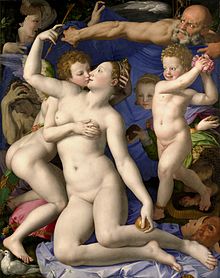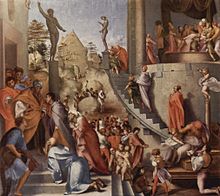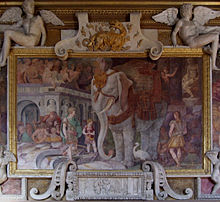- Mannerism
-
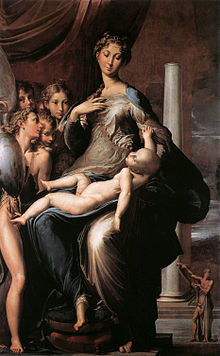 In Parmigianino's Madonna with the Long Neck (1534-40), Mannerism makes itself known by elongated proportions, highly stylized poses, and lack of clear perspective.
In Parmigianino's Madonna with the Long Neck (1534-40), Mannerism makes itself known by elongated proportions, highly stylized poses, and lack of clear perspective.
Mannerism is a period of European art that emerged from the later years of the Italian High Renaissance around 1520. It lasted until about 1580 in Italy, when a more Baroque style began to replace it, but Northern Mannerism continued into the early 17th century throughout much of Europe.[1] Stylistically, Mannerism encompasses a variety of approaches influenced by, and reacting to, the harmonious ideals and restrained naturalism associated with artists such as Leonardo da Vinci, Raphael, and early Michelangelo. Mannerism is notable for its intellectual sophistication as well as its artificial (as opposed to naturalistic) qualities.
The definition of Mannerism, and the phases within it, continues to be the subject of debate among art historians. For example, some scholars have applied the label to certain early modern forms of literature (especially poetry) and music of the 16th and 17th centuries. The term is also used to refer to some Late Gothic painters working in northern Europe from about 1500 to 1530, especially the Antwerp Mannerists—a group unrelated to the Italian movement. Mannerism also has been applied by analogy to the Silver Age of Latin.
Contents
Nomenclature
The word mannerism derives from the Italian maniera, meaning "style" or "manner". Like the English word “style,” maniera can either be used to indicate a specific type of style (a beautiful style, an abrasive style) or be used to indicate an absolute that needs no qualification (someone ‘has style’).[2] In the second edition of his Lives of the Most Excellent Painters, Sculptors, and Architects (1568), Giorgio Vasari used maniera in three different contexts: to discuss an artist's manner or method of working; to describe a personal or group style, such as the term maniera greca to refer to the Byzantine style or simply to the maniera of Michelangelo; and to affirm a positive judgment of artistic quality.[3] Vasari was also a Mannerist artist, and he described the period in which he worked as "la maniera moderna", or the "modern style".[4] James V. Mirollo describes how "bella maniera" poets attempted to surpass in virtuosity the sonnets of Petrarch.[5] The notion of "bella maniera" suggests that artists infected with its spirit looked to copying and bettering their predecessors, rather than confronting nature directly. In essence, "bella maniera" utilized the best from a number of source materials, sythesizing it into something new.[5] Shakespeare's creative approach could be defined in this way.[5]
As a stylistic label, "Mannerism" is not easily pigeonholed. It was used by Swiss historian Jacob Burckhardt and popularized by German art historians in the early 20th century to categorize the seemingly uncategorizable art of the Italian 16th century — art that was no longer perceived to exhibit the harmonious and rational approaches associated with the High Renaissance. “High Renaissance” suggested a period of harmony, grandeur and the revival of classical antiquity and the term was redefined in 1967 by John Shearman.[6] The label “Mannerism” was used during the 16th century to comment on social behaviour and to convey a refined virtuoso quality or to signify a certain technique.
However, for later writers, such as the 17th-century Gian Pietro Bellori, "la maniera" was a derogatory term for the decline of art after Raphael, especially in the 1530s and 1540s.[7] From the late 19th-century on, art historians have commonly used the term to describe art that follows Renaissance classicism and precedes the Baroque. Yet historians differ in opinion, as to whether Mannerism is a style, a movement, or a period, and while the term remains controversial it is commonly used to identify European art and culture of the 16th century.[8]
Early mannerism
Depending on the historical account, Mannerism developed between 1510 and 1520 in either Florence,[9] Rome, or both cities.[10] The early Mannerists in Florence—especially the students of Andrea del Sarto: Jacopo da Pontormo and Rosso Fiorentino—are notable for elongated forms, precariously balanced poses, a collapsed perspective, irrational settings, and theatrical lighting. Parmigianino (a student of Correggio) and Giulio Romano (Raphael’s head assistant) were moving in similarly stylized aesthetic directions in Rome. These artists had matured under the influence of the High Renaissance, and their style has been characterized as a reaction or exaggerated extension of it. Instead of studying nature directly, younger artists began studying Hellenistic sculptures and paintings of masters past. Therefore, this style is often identified as "anti-classical”.[11] yet at the time it was considered a natural progression from the High Renaissance. The earliest experimental phase of Mannerism, known for its "anti-classical" forms, lasted until about 1540 or 1550.[10][page needed] Marcia B. Hall, professor of art history at Temple University, notes in her book 'After Raphael' Raphael's premature death marked the beginning of Mannerism in Rome.
Michelangelo was one of the great creative exponents of Mannerism. His Sistine Chapel ceiling provided examples for other artists to follow, in particular the figures of ignudi and of the Libyan Sibyl. Michelangelo himself could have been influenced by the "Belvedere Torso,” which also influenced other painters.
Raphael’s "Lo Spasimo di Sicilia” depicts an event in Christian history when Christ falls while carrying the cross, sees his mother in distress and is helped up by Simon of Cyrene. The composition is linked by the diagonals of the soldiers’ spears and the wooden cross. However, Christ cannot be singled out immediately among the gathering figures in the foreground, whereas Simon stands out quite prominently. The spectator’s eyes look down the composition to the drama and charge of the narrative.
The competitive spirit that was spurred on by patrons who encouraged the artists to show off their virtuoso painting. When in Florence Leonardo and Michelangelo were each given a commission by Gonfaloniere Piero Soderini to decorate a wall in the “Hall of Five Hundred”. These two artists were set to paint side by side and compete against each other fueling the incentive of being as innovative as possible. Later on in Rome Raphael was commissioned to paint “The Transfiguration” by Cardinal Gioulio di Medici who had been appointed as arch bishop of Narbonne in the south of France. At this time Raphael was also busy painting the Stanze, various altarpieces, painting versions of Madonna and child and being the principal architect in Rome after the death of Bramante, which gave him little time to do “The Transfiguration”. Therefore the cardinal commissioned Sebastiano del Piombo who was great Venetian colourist and a friend of Michelangelo to paint “The Raising of Lazarus”. This spurred Raphael on to complete the commission.
This period has been described as both a natural extension of the art of Andrea del Sarto, Michelangelo, and Raphael, as well as a decline of those same artists' classicizing achievements. In past analyses, it has been noted that mannerism arose in the early 16th century alongside a number of other social, scientific, religious and political movements such as the Copernican model, the Sack of Rome, and the Protestant Reformation's increasing challenge to the power of the Catholic Church. Because of this, the style's elongated forms and distorted forms were once interpreted as a reaction to the idealized compositions prevalent in High Renaissance art.[12] This explanation for the radical stylistic shift c. 1520 has fallen out of scholarly favor, though the early Mannerists are still set in stark contrast to High Renaissance conventions; the immediacy and balance achieved by Raphael's School of Athens, no longer seemed interesting to young artists. Indeed, Michelangelo himself displayed tendencies towards Mannerism, notably in his vestibule to the Laurentian Library, in the figures on his Medici tombs, and above all in his Last Judgment.
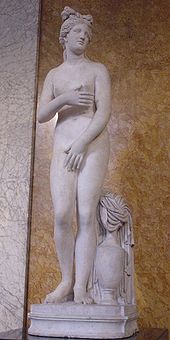 Venus, c. 125; Marble, Roman; British Museum
Venus, c. 125; Marble, Roman; British Museum
High maniera
The second period of Mannerism is commonly differentiated from the earlier, so-called "anti-classical" phase.
Subsequent mannerists stressed intellectual conceits and artistic virtuosity, features that have led later critics to accuse them of working in an unnatural and affected "manner" (maniera). Maniera artists held their elder contemporary Michelangelo as their prime example; theirs was an art imitating art, rather than an art imitating nature. Freedberg argues that the intellectualizing aspect of maniera art comes in the artist expecting his audience to notice and understand this visual reference, the familiar figure in an unfamiliar setting surrounded by "unseen, but felt, quotation marks."[13] The supreme artifice comes in the Maniera painter's love of deliberately mis-appropriating a quotation. Agnolo Bronzino and Giorgio Vasari exemplify this strain of Maniera that lasted from about 1530 to 1580. Based largely at courts and in intellectual circles around Europe, Maniera art couples exaggerated elegance with exquisite attention to surface and detail: porcelain-skinned figures recline in an even, tempered light, regarding the viewer with a cool glance, if at all. The Maniera subject rarely displays an excess of emotion, and for this reason are often interpreted as 'cold' or 'aloof,' and is often called the "stylish" style or the Maniera.[14]
Spread of mannerism
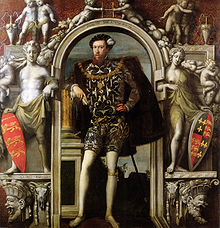 English Mannerism: Henry Howard, Earl of Surrey, 1546, a rare English Mannerist portrait by a Flemish immigrant.
English Mannerism: Henry Howard, Earl of Surrey, 1546, a rare English Mannerist portrait by a Flemish immigrant.
Mannerist centers in Italy were Rome, Florence and Mantua. Venetian painting, in its separate "school," pursued a separate course, represented in the long career of Titian. A number of the earliest Mannerist artists who had been working in Rome during the 1520s fled the city after the Sack of Rome in 1527. As they spread out across the continent in search of employment, their style was distributed throughout Italy and Europe.[15] The result was the first international artistic style since the Gothic.[16] Other parts of Northern Europe did not have the advantage of such intense contact with Italian artists, but the Mannerist style made its presence felt through prints and illustrated books, the purchases of Italian works by rulers, and others, artists' travels to Italy, and the example of individual Italian artists working in the North is called Northern Mannerism. In particular Francis I of France was presented with Bronzino's Venus, Cupid, Folly and Time. The style waned in Italy after 1580, as a new generation of artists, including the Carracci brothers, Caravaggio and Cigoli, reemphasized naturalism. Walter Friedlaender identified this period as "anti-mannerism", just as the early mannerists were "anti-classical" in their reaction to the High Renaissance.[17]
Outside of Italy, however, mannerism continued into the 17th century. In France, where Rosso traveled to work for the court at Fontainebleau, it is known as the "Henry II style" and it had a particular impact on architecture. Other important continental centers include the court of Rudolf II in Prague, as well as Haarlem and Antwerp. Mannerism as a stylistic category is less frequently applied to English visual and decorative arts, where local categories such as "Elizabethan" and "Jacobean" are more common. Seventeenth-century Artisan Mannerism is one exception applied to architecture that relies on pattern books rather than direct precedents in Continental Europe.[18]
Of particular note is the Flemish infection at Fontainebleau that combined the eroticism of the French style with a precursor of the vanitas tradition that would dominate seventeenth-century Netherlandish and Flemish painting. Prevalent at this time was the "pittore vago" those painters from the north that entered the workshops in France and Italy to create a truly international style in art.
Early theorists
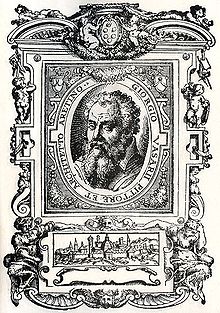 Giorgio Vasari, from Vite de' piu eccellenti pittori, scultori, e archittetori (Lives of the Artists) 1568
Giorgio Vasari, from Vite de' piu eccellenti pittori, scultori, e archittetori (Lives of the Artists) 1568
Giorgio Vasari
Giorgio Vasari's opinions about the art of painting come through in his praise of fellow artists in the great book that lay behind this frontispiece: he believed that excellence in painting demanded refinement, richness of invention (invenzione), expressed through virtuoso technique (maniera), and wit and study that appeared in the finished work, all criteria that emphasized the artist's intellect and the patron's sensibility. The artist was now no longer just a craftsman member of a local Guild of St Luke. Now he took his place at court with scholars, poets, and humanists, in a climate that fostered an appreciation for elegance and complexity. The coat-of-arms of Vasari's Medici patrons appear at the top of his portrait, quite as if they were the artist's own.
The framing of the woodcut image of Mannerist artist Giorgio Vasari's Lives of the Artists (illustration, left) would be called "Jacobean" in an English-speaking context. In it, Michelangelo's Medici tombs inspire the anti-architectural "architectural" features at the top, the papery pierced frame, the satyr nudes at the base. In the vignette of Florence at the base, papery or vellum-like material is cut and stretched and scrolled into a cartouche (cartoccia). The design is self-conscious, overcharged with rich, artificially "natural" detail in physically improbable juxtapositions of jarring scale changes, overwhelming as a mere frame: Mannerist.
Gian Paolo Lomazzo
Another literary source from the period is Gian Paolo Lomazzo, who produced two works—one practical and one metaphysical—that helped define the Mannerist artist's self-conscious relation to his art. His Trattato dell'arte della pittura, scoltura et architettura (Milan, 1584) is in part a guide to contemporary concepts of decorum, which the Renaissance inherited in part from Antiquity but Mannerism elaborated upon. Lomazzo's systematic codification of aesthetics, which typifies the more formalized and academic approaches typical of the later 16th century, controlled a consonance between the functions of interiors and the kinds of painted and sculpted decors that would be suitable. Iconography, often convoluted and abstruse, is a more prominent element in the Mannerist styles. His less practical and more metaphysical Idea del tempio della pittura ("The ideal temple of painting", Milan, 1590) offers a description along the lines of the "four temperaments" theory of the human nature and personality, containing the explanations of the role of individuality in judgment and artistic invention.
Some mannerist examples
Jacopo da Pontormo
Jacopo da Pontormo's Joseph in Egypt stood in what would have been considered contradicting colors and disunified time and space in the Renaissance. Neither the clothing nor the buildings — not even the colors — accurately represented the Bible story of Joseph.
Rosso Francois I Gallery, Château de Fontainebleau, France
Rosso Fiorentino & the School of Fontainebleau
Rosso Fiorentino, who had been a fellow-pupil of Pontormo in the studio of Andrea del Sarto, brought Florentine mannerism to Fontainebleau in 1530, where he became one of the founders of the French 16th century Mannerism called the "School of Fontainebleau".
The examples of a rich and hectic decorative style at Fontainebleau transferred the Italian style, through the medium of engravings, to Antwerp and thence throughout Northern Europe, from London to Poland, and brought Mannerist design into luxury goods like silver and carved furniture. A sense of tense controlled emotion expressed in elaborate symbolism and allegory, and elongated proportions of female beauty are characteristics of his style.
Agnolo Bronzino
Mannerist portraits by Agnolo Bronzino are distinguished by a still elegance and meticulous attention to detail. As a result, Bronzino's sitters (at left) have been said to put an uncommunicative abyss between subject and viewer, concentrating on rendering of the precise pattern and sheen of rich textiles.
Alessandro Allori
Alessandro Allori's (1535–1607) Susanna and the Elders (below) uses artificial, waxy eroticism and consciously brilliant still life detail, in a crowded contorted composition.
Tintoretto
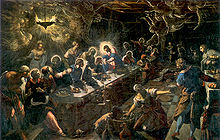 Tintoretto, Last Supper
Tintoretto, Last Supper
Tintoretto's Last Supper (at right) epitomizes Mannerism by taking Jesus and the table out of the middle of the room. He showed all that was happening. The painting emphasizes light and motion, dramatizing the image. Unlike more traditional views of the Last Supper, he depicts Heaven opening up into the room, and the angels looking on in awe, per the old Catholic maxim that "If the angels were capable of envy, they would envy the Eucharist."
El Greco
El Greco attempted to express the religious tension with exaggerated Mannerism. This exaggeration would serve to cross over the Mannerist line and be applied to Classicism. After the realistic depiction of the human form and the mastery of perspective achieved in high Renaissance Classicism, some artists started to deliberately distort proportions in disjointed, irrational space for emotional and artistic effect. Key aspects of Mannerism in El Greco include the jarring "acid" color sense, elongated and tortured anatomy, irrational perspective and light, and obscure and troubling iconography.[19][20]
Benvenuto Cellini
Benvenuto Cellini created the Cellini Salt Cellar of gold and enamel in 1540 featuring Poseidon and Amphitrite (water and earth) in elongated form and uncomfortable positions. It is considered a masterpiece of Mannerist sculpture.
Joachim Wtewael
Joachim Wtewael's style is noted for certain similarity with Da Vinci's naturalist composition and character/landscape interaction albeit with a typically mannerist palette of pastel tones. Quoting Gérard de Nerval Art Historian Jean-Yves Heurtebise has further proposed that Dutch mannerism would typically use an otherwise general principle of Art History consisting of "the ability to capture what is different and to become different itself in this process" [21]
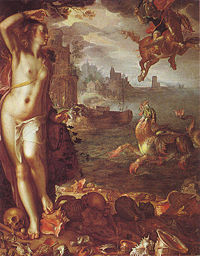 Joachim Wtewael Perseus and Andromeda, 1616, Louvre Museum. Note the composition displaying a Vanité of bones and seashells in the foreground and an elaborate academic nude with a palette borrowing from the forefront for Andromeda's cheeks. The Dragon seems of sino-oriental influence. The scene is taken from Boccacio's verion of Ovid's Metamorphosis
Joachim Wtewael Perseus and Andromeda, 1616, Louvre Museum. Note the composition displaying a Vanité of bones and seashells in the foreground and an elaborate academic nude with a palette borrowing from the forefront for Andromeda's cheeks. The Dragon seems of sino-oriental influence. The scene is taken from Boccacio's verion of Ovid's Metamorphosis
Giuseppe Arcimboldo
Giuseppe Arcimboldo (also spelled Arcimboldi) is known for his portraits using a still life composition to which later Surrealism would be reminiscent. Arcimboldo will notably influence German painter Michael Mathias Prechtl (1929-2003) in his portrait of Franz Kafka [22]
Mannerist architecture
Main article: Renaissance architecture#Mannerism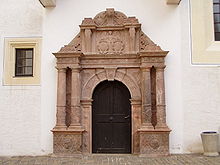 The rhyolitic tuff portal of the "church house" at Colditz Castle, Saxony, designed by Andreas Walther II (1584), is a clear example of the exuberance of "Antwerp Mannerism".
The rhyolitic tuff portal of the "church house" at Colditz Castle, Saxony, designed by Andreas Walther II (1584), is a clear example of the exuberance of "Antwerp Mannerism".
An example of mannerist architecture is the Villa Farnese at Caprarola in the rugged country side outside of Rome. The proliferation of engravers during the 16th century spread Mannerist styles more quickly than any previous styles. A center of Mannerist design was Antwerp during its 16th century boom. Through Antwerp, Renaissance and Mannerist styles were widely introduced in England, Germany, and northern and eastern Europe in general. Dense with ornament of "Roman" detailing, the display doorway at Colditz Castle (illustration, left) exemplifies this northern style, characteristically applied as an isolated "set piece" against unpretentious vernacular walling.
Mannerism in literature and music
See also: Metaphysical poetsIn English literature, Mannerism is commonly identified with the qualities of the "Metaphysical" poets of whom the most famous is John Donne.[citation needed] The witty sally of a Baroque writer, John Dryden, against the verse of Donne in the previous generation, affords a concise contrast between Baroque and Mannerist aims in the arts:
He affects the metaphysics, not only in his satires but in his amorous verses, where nature only should reign; and perplexes the minds of the fair sex with nice[23] speculations of philosophy when he should engage their hearts and entertain them with the softnesses of love.[cite this quote] (italics added)The rich musical possibilities in the poetry of the late 16th and early 17th centuries provided an attractive basis for the madrigal, which quickly rose to prominence as the pre-eminent musical form in Italian musical culture, as discussed by Tim Carter:
The madrigal, particularly in its aristocratic guise, was obviously a vehicle for the ‘stylish style’ of Mannerism, with poets and musicians revelling in witty conceits and other visual, verbal and musical tricks to delight the connoisseur.[24]The word Mannerism has also been used to describe the style of highly florid and contrapuntally complex polyphonic music made in France in the late 14th century.[25] This period is now usually referred to as the ars subtilior.
Mannerism and Theatre
The Early Commedia dell'Arte (1550–1621): The Mannerist Context by Paul Castagno discusses Mannerism's infection of the contemporary professional theatre.[26] Castagno's was the first study to define a theatrical form as Mannerist, employing the vocabulary of Mannerism and maniera to discuss the typification, exaggerated, and effetto meraviglioso of the comici dell'arte. See Part II of the above book for a full discussion of Mannerist characteristics in the commedia dell'arte.} The study is largely iconographic, presenting a pictorial evidence that many of the artists who painted or printed commedia images were in fact, coming from the workshops of the day, heavily ensconced in the maniera tradition.
The preciocity in Jacques Callot's minute engravings seem to belie a much larger scale of action. Callot's Balli di Sfessania (literally, dance of the buttocks) celebrates the commedia's blatant eroticism, with protruding phalli, spears posed with the anticipation of a comic ream, and grossly exaggerated masks that mix the bestial with human. The eroticism of the innamorate (lovers) including the bearing of breasts, or excessive veiling, was quite in vogue in the paintings and engravings from the second school at Fontainebleau, particularly those that detect a Franco-Flemish influence. Castagno demonstrates iconographic linkages between genre painting and the figures of the commedia dell'arte that demonstrate how this theatrical form was embedded within the cultural traditions of the late cinquecento.[27]
Commedia dell'arte, disegno interno, and the discordia concors
Important corollaries exist between the disegno interno, which substituted for the disegno esterno (external design) in mannerist painting. This notion of projecting a deeply subjective view as superseding nature or established principles (perspective, for example), in essence, the emphasis away from the object to its subject, now emphasizing execution, displays of virtuosity, or unique techniques. This inner vision is at the heart of commedia performance. For example, in the moment of improvisation the actor expresses his virtuosity without heed to formal boundaries, decorum, unity, or text. Arlecchino became emblemmatic of the mannerist discordia concors (the union of opposites), at one moment he would be gentle and kind, then, on a dime, become a thief violently acting out with his batte. Arlecchino could be graceful in movement, only in the next beat, to clumsily trip over his feet. Freed from the external rules, the actor celebrated the evanescence of the moment; much the way Cellini would dazzle his patrons by draping his sculptures, unveiling them with lighting effects and a sense of the marvelous. The presentation of the object became as important as the object itself.
See also
- Counter-Mannerism
- Mannerist architecture and sculpture in Poland
- Timeline of Italian artists to 1800
Notes
- ^ Freedberg 1971, 483.
- ^ John Shearman, “Maniera as an Aesthetic Ideal”, in Cheney 2004, 37.
- ^ Cheney 1997, 17.
- ^ Briganti 1961, 6.
- ^ a b c Mirollo 1984,[page needed]
- ^ Shearman 1967.
- ^ Smyth 1962, 1–2.
- ^ Cheney[citation needed], "Preface", xxv-xxxii, and Manfred Wundram, "Mannerism," Grove Art Online. Oxford University Press, [accessed 23 April 2008].
- ^ Friedländer 1965,[page needed]
- ^ a b Freedberg 1993, 175–77.
- ^ Friedländer 1965,[page needed].
- ^ Manfred Wundram, "Mannerism," Grove Art Online. Oxford University Press, [accessed 23 April 2008].
- ^ Sydney Freedberg, "Observations on the Painting of the Maniera," 1965. Republished in Cheney 2004, 116–23.
- ^ Shearman 1967,[page needed]
- ^ Briganti 1961, 32-33
- ^ Briganti 1961, 13.
- ^ Friedländer 1957,[page needed].
- ^ Summerson 1983, 157–72.
- ^ National Gallery of Art - El Greco
- ^ Metropolitan Museum of Art El Greco (Domenikos Theotokopoulos) (1541–1614)
- ^ Jean-Yves Heurtebise, Essai d'une Géographie Symbolique de la Morale Le Portique May 2007 http://leportique.revues.org/index1533.html
- ^ a view of the painting is available here http://s156.photobucket.com/albums/t26/schmollmond/?action=view¤t=prechtlkafkaarcimboldesk.jpg&mobile=true
- ^ 'Nice' in the sense of 'finely reasoned.'
- ^ Carter, Tim. The Early Madrigal in Music in Late Renaissance and Early Baroque Italy, (Amadeus Press: London, 1991) p. 128
- ^ Apel 1946–47, 20.
- ^ Castagno 1992,[page needed].
- ^ Castagno 1994,[page needed].
References
- Apel, Willi. 1946–47. "The French Secular Music of the Late Fourteenth Century". Acta Musicologica 18: 17–29.
- Briganti, Giuliano. 1962. Italian Mannerism, translated from the Italian by Margaret Kunzle. London: Thames and Hudson; Princeton: Van Nostrand; Leipzig: VEB Edition. (Originally published in Italian, as La maniera italiana, La pittura italiana 10. Rome: Editori Riuniti, 1961).
- Castagno, Paul C. 1994. The Early Commedia Dell'arte (1550–1621): The Mannerist Context. New York: P. Lang. ISBN 0820417947.
- Cheney, Liana de Girolami (ed.). 2004. Readings in Italian Mannerism, second printing, with a foreword by Craig Hugh Smyth. New York: Peter Lang. ISBN 0820470635. (Previous edition, without the forward by Smyth, New York: Peter Lang, 1997. ISBN 0820424838).
- Freedberg, Sidney J. 1971. Painting in Italy, 1500–1600, first edition. The Pelican History of Art. Harmondsworth and Baltimore: Penguin Books. ISBN 0140560351
- Freedberg, Sidney J. 1993. Painting in Italy, 1500–1600, 3rd edition, New Haven and London: Yale University Press. ISBN 0300055862 (cloth) ISBN 0300055870 (pbk)
- Friedländer, Walter. 1965. Mannerism and Anti-Mannerism in Italian Painting. New York: Schocken. LOC 578295 (First edition, New York: Columbia University Press, 1958.)
- Mirollo, James V. 1984. Mannerism and Renaissance Poetry: Concept, Mode, Inner Design. New Haven: Yale University Press. ISBN 0300032277.
- Shearman, John K. G. 1967. Mannerism. Style and Civilization. Harmondsworth: Penguin. Reprinted, London and New York: Penguin, 1990. ISBN 0140137599
- Smyth, Craig Hugh. 1992. Mannerism and Maniera, with an introduction by Elizabeth Cropper. Vienna: IRSA. ISBN 3900731330.
- Summerson, John. 1983. Architecture in Britain 1530–1830, 7th revised and enlarged (3rd integrated) edition. The Pelican History of Art. Harmondsworth and New York: Penguin. ISBN 0140560033 (cased) ISBN 014056103X (pbk) [Reprinted with corrections, 1986; 8th edition, Harmondsworth and New York: Penguin, 1991.]
Further reading
- Gardner, Helen Louise. 1972. The Metaphysical Poets, Selected and Edited, revised edition. Introduction. Harmondsworth, England; New York: Penguin Books. ISBN 014042038X.
- Hall, Marcia B . 2001. "After Raphael: Painting in Central Italy in the Sixteenth Century", Cambridge University Press. ISBN 0521483972.
- Pinelli, Antonio. 1993. La bella maniera: artisti del Cinquecento tra regola e licenza. Turin: Piccola biblioteca Einaudi. ISBN 8806131370
- Sypher, Wylie. 1955. Four Stages of Renaissance Style: Transformations in Art and Literature, 1400-1700. Garden City, N.Y.: Doubleday. A classic analysis of Renaissance, Mannerism, Baroque, and Late Baroque.
- Würtenberger, Franzsepp. 1963. Mannerism: The European Style of the Sixteenth Century. New York: Holt, Rinehart and Winston (Originally published in German, as Der Manierismus; der europäische Stil des sechzehnten Jahrhunderts. Vienna: A. Schroll, 1962).
Categories:- Mannerism
- Mannerist architecture
- Architectural styles
- Renaissance architecture
- 16th century in art
Wikimedia Foundation. 2010.




